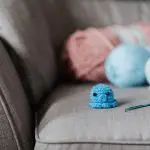Hey there, wanna add a personal touch to your yarn projects? Look no further!
You can easily master the art of hand dyeing yarn with these 5 simple techniques. From Kool-Aid dyeing to tie-dyeing, there's a method for every style.
You'll learn to create vibrant, custom-colored yarn that's perfect for your next knitting or crochet project.
So, grab your supplies and get ready to dive into the world of hand dyeing. Let's turn that plain yarn into a masterpiece!
Key Takeaways
- Kool-Aid dyeing and speckle dyeing are two easy methods to hand dye yarn using Kool-Aid powder.
- Tie-dyeing allows for creative freedom and the opportunity to create unique and visually interesting yarn designs.
- Dip dyeing offers versatility and the ability to achieve a seamless gradient effect by gradually dipping the yarn into different colored dye baths.
- Hand painting allows for experimentation with various techniques and colors to create unique combinations on the yarn.
Kool-Aid Dyeing
When hand dyeing yarn with Kool-Aid, start by preparing a dye bath according to the desired color intensity. Kool-Aid contains fruit colorants, making it a fun and natural way to dye yarn.
To begin, fill a microwave-safe bowl with water and add the Kool-Aid powder. The amount of powder used will determine the depth of color, so feel free to experiment with different quantities.
Once the dye bath is prepared, soak the yarn in water and then submerge it into the Kool-Aid mixture. After ensuring the yarn is evenly saturated, place the bowl in the microwave and heat it in short intervals. This microwave dyeing technique allows for quick and efficient color setting. Be cautious when handling the hot bowl and use protective gear as needed.
Once the yarn has absorbed the dye, carefully remove it from the bowl and let it cool before rinsing. Heat setting is crucial to ensure the color remains vibrant and doesn't wash out.
Speckle Dyeing
To achieve speckle dyeing, prepare a dye bath with water and Kool-Aid powder, using the same yarn that soaked in the previous subtopic's dye bath. This technique allows you to create unique patterns and achieve beautiful color blending on your yarn. Speckle dyeing is one of the most exciting hand dyeing techniques, and the color application is key to its success.
To begin, prepare your dye bath by mixing water and Kool-Aid powder in a pot. Bring the mixture to a simmer, then add your pre-soaked yarn. Using a spoon or a syringe, apply small, concentrated dots of color to the yarn. You can also flick the dye onto the yarn for a speckled effect. Allow the yarn to simmer in the dye bath until the desired color intensity is achieved, then rinse and dry as in the previous subtopic.
Speckle dyeing offers endless possibilities for experimentation and creativity. Whether you're a beginner or an experienced dyer, this technique allows you to play with color and pattern in an exciting way. Once you master speckle dyeing, you'll be able to create stunning, one-of-a-kind yarns for your knitting and crochet projects.
Tie-Dyeing
After you have experimented with speckle dyeing, you can move on to the fun and vibrant technique of tie-dyeing your yarn. Tie-dyeing allows you to create beautiful, multi-colored yarn with unique patterns and effects. There are various tie-dyeing techniques and color combinations to explore, each offering a different result. One popular tie-dye method is Shibori tie dye, which involves folding, twisting, and binding the yarn before applying the dyes to create intricate patterns. You can also experiment with different pattern variations, such as spirals, bullseyes, or stripes, to add visual interest to your yarn.
To help you get started with tie-dyeing, here's a table outlining some common tie-dye techniques and color combinations:
| Tie-Dye Technique | Color Combinations |
|---|---|
| Shibori | Blue and white, Indigo and teal |
| Spiral | Rainbow, Pastel shades |
| Bullseye | Red and yellow, Purple and pink |
Dip Dyeing
You can easily achieve vibrant and gradient effects by dip dyeing yarn in different colored dyes. This technique allows you to create a smooth transition of colors, resulting in stunning and unique yarns for your projects.
- Color Blending
- Start by preparing multiple dye baths in different colors. Choose colors that blend well together to create a harmonious gradient effect.
- Dip one end of the skein into the lightest dye bath first, allowing the yarn to absorb the color. Gradually lift the yarn out of the dye bath, leaving a portion still submerged.
- Gradient Effects
- After dyeing the first section, dip the yarn into the next dye bath, which should be slightly darker than the previous one. Continue to lift the yarn out gradually to achieve a seamless gradient.
- Repeat the process with the remaining dye baths, ensuring that each color transition is smooth and visually appealing.
Dip dyeing offers a versatile way to play with colors, allowing you to experiment with different combinations and create one-of-a-kind yarns. Mastering this technique will give you the ability to produce beautiful gradient effects that will enhance your knitting or crochet projects.
Hand Painting
For hand painting yarn, gather your materials and prepare a clean workspace to prevent any potential spills or messes. This technique allows you to get creative with your yarn by using various methods such as watercolor techniques, resist methods, color blending, and stenciling techniques.
To start, soak your yarn in water and then gently squeeze out the excess. Lay the damp yarn on a clean surface and use your chosen dyes to paint directly onto the yarn. You can experiment with color blending by mixing different dyes together directly on the yarn, creating unique and beautiful combinations.
Resist methods involve using substances like wax or certain types of yarn to create patterns by preventing the dye from reaching certain areas of the yarn. Stenciling techniques can also be used to create specific shapes or patterns on the yarn.
Once you've finished applying the dyes, allow the yarn to dry completely. Heat setting the colors will help ensure they remain vibrant and long-lasting. With hand painting, you have the freedom to let your creativity shine through, producing one-of-a-kind yarn for your projects.
Frequently Asked Questions
Can I Use Natural Dyes Like Plants or Vegetables to Dye Yarn?
Yes, you can use natural dyes like plants or vegetables to dye yarn. Plant-based dyes offer a range of beautiful colors, but color fastness and variations can occur, so it's important to experiment and test.
What Are Some Tips for Achieving a Consistent Color When Hand Dyeing Yarn?
When hand dyeing yarn, achieving a consistent color is key. To achieve this, start by pre-soaking your yarn and using proper measuring techniques for dye. Keep an eye on temperature and agitation during the dyeing process for best results.
How Can I Prevent the Dye From Fading or Bleeding When Washing the Yarn?
To prevent bleeding and fading when washing hand-dyed yarn, use color fixatives and follow fiber type restrictions. For animal fibers, use vinegar or citric acid, and for plant fibers, use soda ash. Always test for colorfastness.
What Are Some Alternative Methods for Setting the Dye in Yarn, Other Than Using Vinegar or Citric Acid?
To set the dye in yarn without vinegar or citric acid, try alternative fixatives like soda ash or urea. You can also use heat setting methods, such as the microwave technique, to ensure the dye stays vibrant and doesn't bleed when washing.
Are There Any Special Considerations for Dyeing Yarn Made From Different Types of Fibers, Such as Wool, Cotton, or Silk?
When dyeing yarn made from different fiber types like wool, cotton, or silk, it's crucial to consider their unique characteristics. Each fiber requires specific dyeing techniques and may respond differently when blending natural and synthetic dyes.
- How Does Ring Spun Cotton Affect Garment Fit and Shape Retention? - August 13, 2024
- What Are the Challenges in Producing Ring Spun Cotton? - August 13, 2024
- Is Ring Spun Cotton Suitable for Plus-Size Clothing? - August 13, 2024




